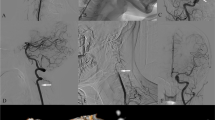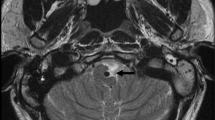Abstract
Whether the rotational vertebral artery syndrome (RVAS), consisting of attacks of vertigo, nystagmus and tinnitus elicited by head-rotation induced compression of the dominant vertebral artery (VA), reflects ischemic dysfunction of uni- or bilateral peripheral or central vestibular structures, is still debated. We report on a patient with bilateral high-grade carotid stenoses, in whom rightward headrotation led to RVAS symptoms including a prominent nystagmus. Three-dimensional kinematic analysis of the nystagmus pattern, recorded with search coils, revealed major downbeat nystagmus with minor horizontal and torsional components. Magnetic resonance angiography demonstrated a hypoplastic right VA terminating in the posterior inferior cerebellar artery, a dominant left VA, and a hypoplastic P1-segment of the left posterior cerebral artery (PCA) that was supplied by the left posterior communicating artery (PCoA). The right PCA and both anterior inferior cerebellar arteries were supplied by the basilar artery. The right PCoA originated from the right internal carotid artery. Color duplex sonography showed severe reduction of diastolic blood flow velocities in the left VA during RVAS attacks. The nystagmus pattern can be best explained by vectorial addition of 3D sensitivity vectors of stimulated right and left anterior and horizontal semicircular canals with slightly stronger stimulation on the left side. We hypothesize that in RVAS, compression of dominant VA leads to acute vertebrobasilar insufficiency with bilateral, but asymmetric ischemia of the superior labyrinth. With regard to RVAS etiology, our case illustrates a type of pure vascular RVAS. Severity of attacks markedly decreased after successful bilateral carotid endarterectomy.
Similar content being viewed by others
References
Kuether TA, Nesbit GM, Clark WM, Barnwell SL (1997) Rotational vertebral artery occlusion: a mechanism of vertebrobasilar insufficiency. Neurosurgery 41:427–432
Strupp M, Planck JH, Arbusow V, Steiger HJ, Bruckmann H, Brandt T (2000) Rotational vertebral artery occlusion syndrome with vertigo due to "labyrinthine excitation". Neurology 54:1376–1379
Brandt T, Baloh RW (2005) Rotational vertebral artery occlusion: a clinical entity or various syndromes? Neurology 65:1156–1157
Choi KD, Shin HY, Kim JS, Kim SH, Kwon OK, Koo JW, Park SH, Yoon BW, Roh JK (2005) Rotational vertebral artery syndrome: oculographic analysis of nystagmus. Neurology 65:1287–1290
Sturzenegger M, Newell DW, Douville C, Byrd S, Schoonover K (1994) Dynamic transcranial Doppler assessment of positional vertebrobasilar ischemia. Stroke 25:1776–1783
Mazzoni A (1990) The vascular anatomy of the vestibular labyrinth in man. Acta Otolaryngol Suppl 472:1–83
Tatlow W, Bammer H (2006) Syndromes of vertebral artery compression. Neurology 7:331–340
Sitko S, Honrubia V (1986) Differential effect of ischemia on spontaneous and sinusoidal-evoked activity in semicircular canal afferents in the bullfrog. Acta Otolaryngol 102:179–185
Baloh RW, Baloh RW, Halmagyi MG (1996) Vestibular disorders due to cerebrovascular disease. In: Disorders of the vestibular system. Oxford Press, New York, pp 418–429
Kim JS, Lopez I, DiPatre PL, Liu F, Ishiyama A, Baloh RW (1999) Internal auditory artery infarction: Clinicopathologic correlation. Neurology 52:40–44
Zee DS, Yamazaki A, Butler PH, Gucer G (1981) Effects of ablation of flocculus and paraflocculus of eye movements in primate. J Neurophysiol 46:878–899
Leigh RJ, Zee DS (2006) The Neurology of Eye Movements. 4th Edition. Oxford Press
Cohen B, Suzuki JI, Bender MB (1964) Eye movements from semicircular canal nerve stimulation in the cat. Ann Otol Rhinol Laryngol 73:153–169
Author information
Authors and Affiliations
Corresponding author
Rights and permissions
About this article
Cite this article
Marti, S., Hegemann, S., von Büdingen, HC. et al. Rotational vertebral artery syndrome. J Neurol 255, 663–667 (2008). https://doi.org/10.1007/s00415-008-0773-2
Received:
Revised:
Accepted:
Published:
Issue Date:
DOI: https://doi.org/10.1007/s00415-008-0773-2




